Values and Ethics in Social Care: Case Study of a Nursing Home
VerifiedAdded on 2023/06/14
|9
|2494
|495
Essay
AI Summary
This essay delves into the ethical dilemmas and core values present within a nursing home setting. It addresses issues such as a staff member's refusal to serve a gay patient due to religious beliefs, an elderly patient's abuse of minority staff, concerns about hygiene, and debates over the appropriate care for dementia patients. The essay discusses the importance of empathy, communication, and critical thinking in nursing, emphasizing respect for patient dignity and autonomy. It also examines how cultural and religious values influence personal ethics and suggests recommendations for improving cultural sensitivity and ethical practices within healthcare, including staff training and promoting patient trust. This document is available on Desklib, a platform offering a wide array of study tools and solved assignments for students.

Running head: values and ethics in social care and health sector
STUDENT ID:
STUDENT ROLL NO.:
SUBJEVT CODE:
VALUES AND ETHICS IN SOCIAL CARE AND HEALTH
SECTOR
STUDENT ID:
STUDENT ROLL NO.:
SUBJEVT CODE:
VALUES AND ETHICS IN SOCIAL CARE AND HEALTH
SECTOR
Paraphrase This Document
Need a fresh take? Get an instant paraphrase of this document with our AI Paraphraser
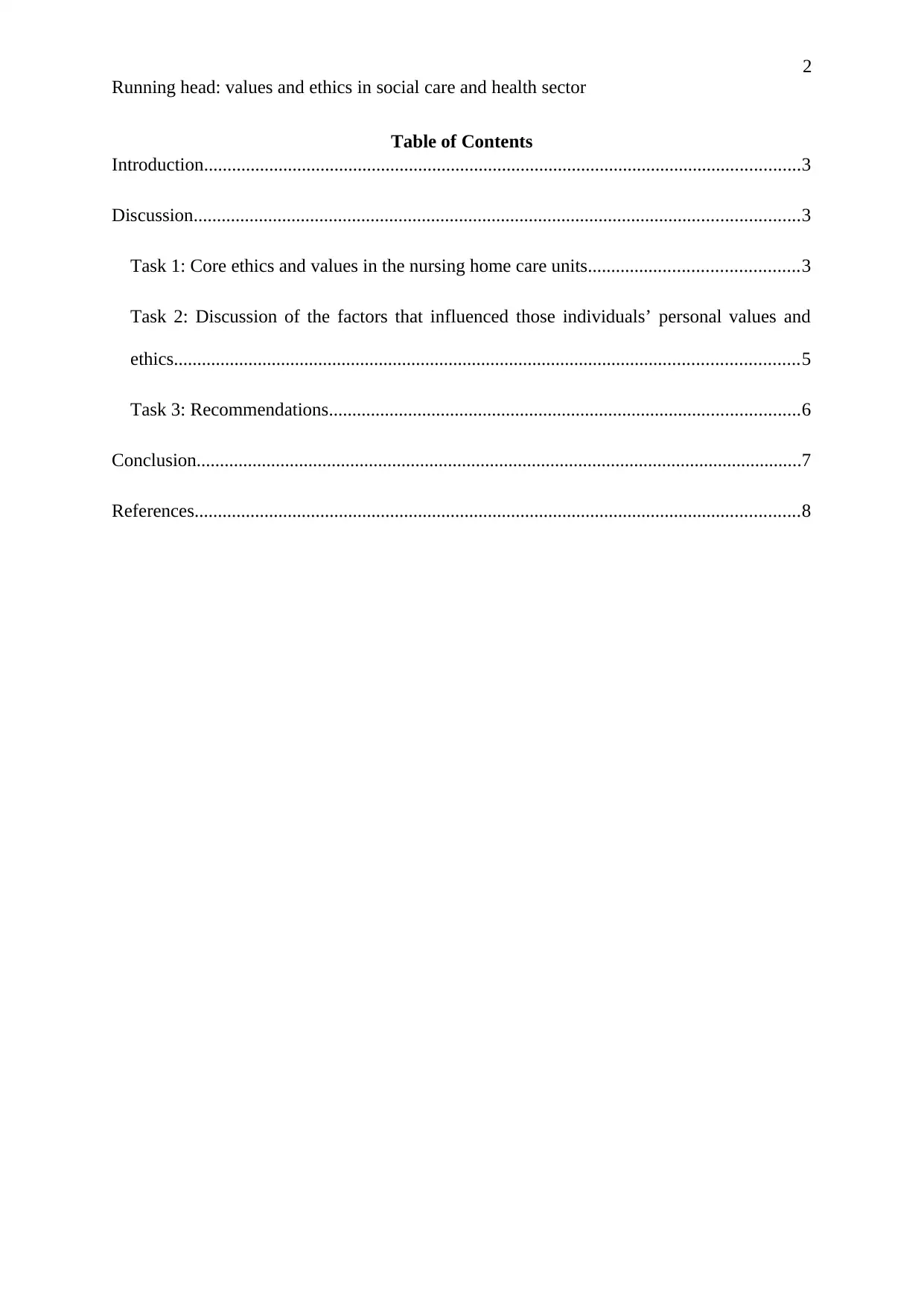
2
Running head: values and ethics in social care and health sector
Table of Contents
Introduction................................................................................................................................3
Discussion..................................................................................................................................3
Task 1: Core ethics and values in the nursing home care units.............................................3
Task 2: Discussion of the factors that influenced those individuals’ personal values and
ethics......................................................................................................................................5
Task 3: Recommendations.....................................................................................................6
Conclusion..................................................................................................................................7
References..................................................................................................................................8
Running head: values and ethics in social care and health sector
Table of Contents
Introduction................................................................................................................................3
Discussion..................................................................................................................................3
Task 1: Core ethics and values in the nursing home care units.............................................3
Task 2: Discussion of the factors that influenced those individuals’ personal values and
ethics......................................................................................................................................5
Task 3: Recommendations.....................................................................................................6
Conclusion..................................................................................................................................7
References..................................................................................................................................8
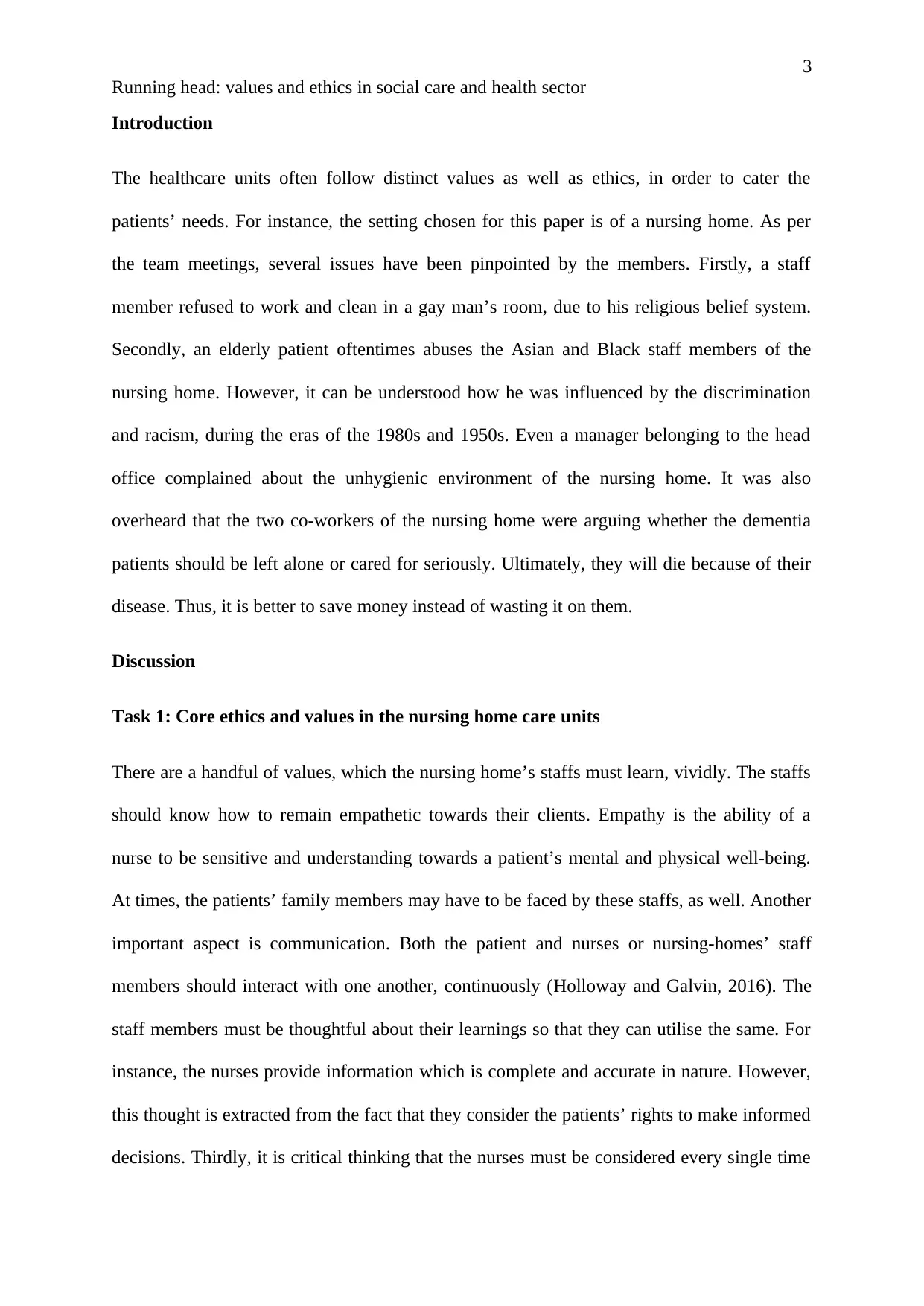
3
Running head: values and ethics in social care and health sector
Introduction
The healthcare units often follow distinct values as well as ethics, in order to cater the
patients’ needs. For instance, the setting chosen for this paper is of a nursing home. As per
the team meetings, several issues have been pinpointed by the members. Firstly, a staff
member refused to work and clean in a gay man’s room, due to his religious belief system.
Secondly, an elderly patient oftentimes abuses the Asian and Black staff members of the
nursing home. However, it can be understood how he was influenced by the discrimination
and racism, during the eras of the 1980s and 1950s. Even a manager belonging to the head
office complained about the unhygienic environment of the nursing home. It was also
overheard that the two co-workers of the nursing home were arguing whether the dementia
patients should be left alone or cared for seriously. Ultimately, they will die because of their
disease. Thus, it is better to save money instead of wasting it on them.
Discussion
Task 1: Core ethics and values in the nursing home care units
There are a handful of values, which the nursing home’s staffs must learn, vividly. The staffs
should know how to remain empathetic towards their clients. Empathy is the ability of a
nurse to be sensitive and understanding towards a patient’s mental and physical well-being.
At times, the patients’ family members may have to be faced by these staffs, as well. Another
important aspect is communication. Both the patient and nurses or nursing-homes’ staff
members should interact with one another, continuously (Holloway and Galvin, 2016). The
staff members must be thoughtful about their learnings so that they can utilise the same. For
instance, the nurses provide information which is complete and accurate in nature. However,
this thought is extracted from the fact that they consider the patients’ rights to make informed
decisions. Thirdly, it is critical thinking that the nurses must be considered every single time
Running head: values and ethics in social care and health sector
Introduction
The healthcare units often follow distinct values as well as ethics, in order to cater the
patients’ needs. For instance, the setting chosen for this paper is of a nursing home. As per
the team meetings, several issues have been pinpointed by the members. Firstly, a staff
member refused to work and clean in a gay man’s room, due to his religious belief system.
Secondly, an elderly patient oftentimes abuses the Asian and Black staff members of the
nursing home. However, it can be understood how he was influenced by the discrimination
and racism, during the eras of the 1980s and 1950s. Even a manager belonging to the head
office complained about the unhygienic environment of the nursing home. It was also
overheard that the two co-workers of the nursing home were arguing whether the dementia
patients should be left alone or cared for seriously. Ultimately, they will die because of their
disease. Thus, it is better to save money instead of wasting it on them.
Discussion
Task 1: Core ethics and values in the nursing home care units
There are a handful of values, which the nursing home’s staffs must learn, vividly. The staffs
should know how to remain empathetic towards their clients. Empathy is the ability of a
nurse to be sensitive and understanding towards a patient’s mental and physical well-being.
At times, the patients’ family members may have to be faced by these staffs, as well. Another
important aspect is communication. Both the patient and nurses or nursing-homes’ staff
members should interact with one another, continuously (Holloway and Galvin, 2016). The
staff members must be thoughtful about their learnings so that they can utilise the same. For
instance, the nurses provide information which is complete and accurate in nature. However,
this thought is extracted from the fact that they consider the patients’ rights to make informed
decisions. Thirdly, it is critical thinking that the nurses must be considered every single time
⊘ This is a preview!⊘
Do you want full access?
Subscribe today to unlock all pages.

Trusted by 1+ million students worldwide
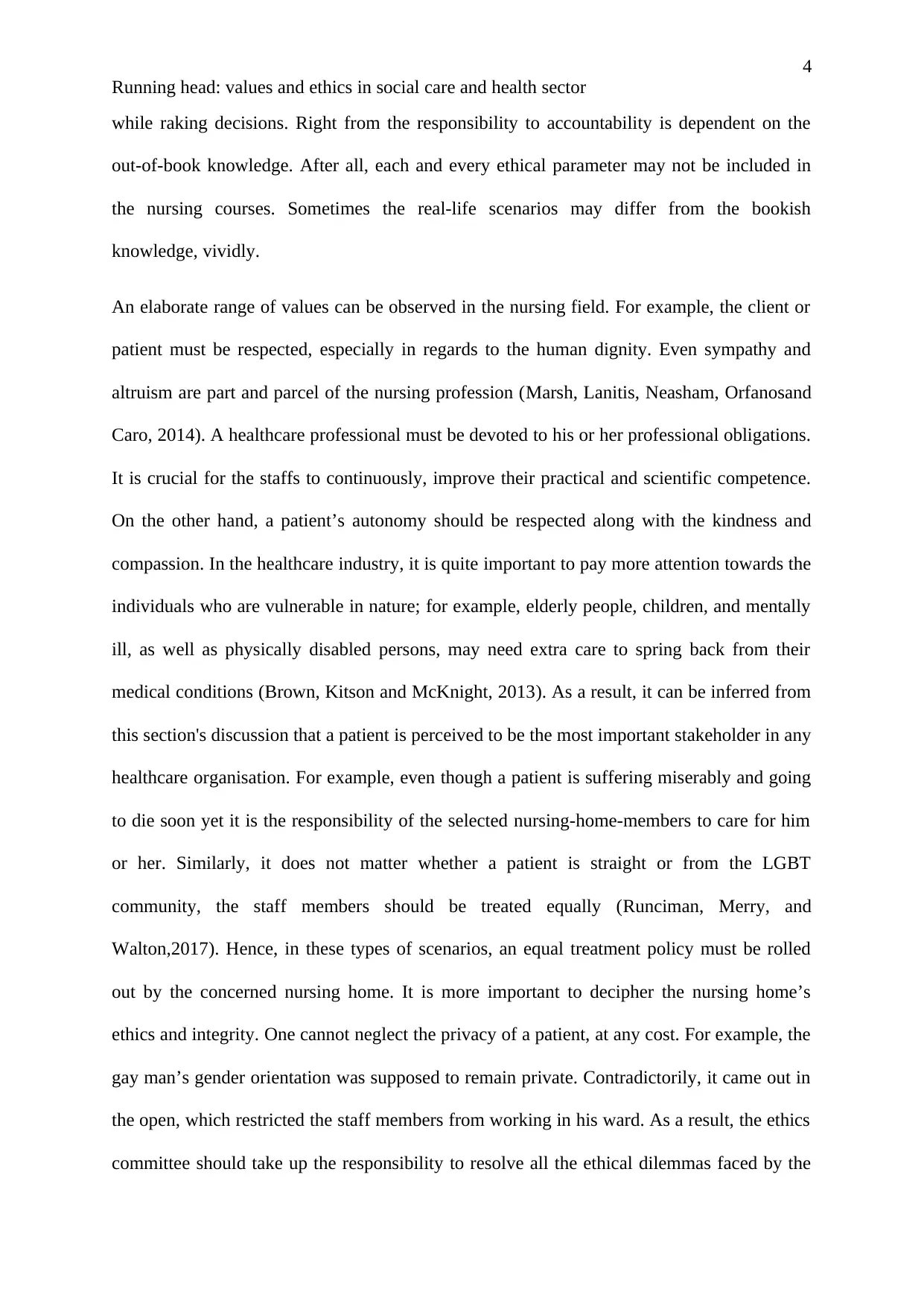
4
Running head: values and ethics in social care and health sector
while raking decisions. Right from the responsibility to accountability is dependent on the
out-of-book knowledge. After all, each and every ethical parameter may not be included in
the nursing courses. Sometimes the real-life scenarios may differ from the bookish
knowledge, vividly.
An elaborate range of values can be observed in the nursing field. For example, the client or
patient must be respected, especially in regards to the human dignity. Even sympathy and
altruism are part and parcel of the nursing profession (Marsh, Lanitis, Neasham, Orfanosand
Caro, 2014). A healthcare professional must be devoted to his or her professional obligations.
It is crucial for the staffs to continuously, improve their practical and scientific competence.
On the other hand, a patient’s autonomy should be respected along with the kindness and
compassion. In the healthcare industry, it is quite important to pay more attention towards the
individuals who are vulnerable in nature; for example, elderly people, children, and mentally
ill, as well as physically disabled persons, may need extra care to spring back from their
medical conditions (Brown, Kitson and McKnight, 2013). As a result, it can be inferred from
this section's discussion that a patient is perceived to be the most important stakeholder in any
healthcare organisation. For example, even though a patient is suffering miserably and going
to die soon yet it is the responsibility of the selected nursing-home-members to care for him
or her. Similarly, it does not matter whether a patient is straight or from the LGBT
community, the staff members should be treated equally (Runciman, Merry, and
Walton,2017). Hence, in these types of scenarios, an equal treatment policy must be rolled
out by the concerned nursing home. It is more important to decipher the nursing home’s
ethics and integrity. One cannot neglect the privacy of a patient, at any cost. For example, the
gay man’s gender orientation was supposed to remain private. Contradictorily, it came out in
the open, which restricted the staff members from working in his ward. As a result, the ethics
committee should take up the responsibility to resolve all the ethical dilemmas faced by the
Running head: values and ethics in social care and health sector
while raking decisions. Right from the responsibility to accountability is dependent on the
out-of-book knowledge. After all, each and every ethical parameter may not be included in
the nursing courses. Sometimes the real-life scenarios may differ from the bookish
knowledge, vividly.
An elaborate range of values can be observed in the nursing field. For example, the client or
patient must be respected, especially in regards to the human dignity. Even sympathy and
altruism are part and parcel of the nursing profession (Marsh, Lanitis, Neasham, Orfanosand
Caro, 2014). A healthcare professional must be devoted to his or her professional obligations.
It is crucial for the staffs to continuously, improve their practical and scientific competence.
On the other hand, a patient’s autonomy should be respected along with the kindness and
compassion. In the healthcare industry, it is quite important to pay more attention towards the
individuals who are vulnerable in nature; for example, elderly people, children, and mentally
ill, as well as physically disabled persons, may need extra care to spring back from their
medical conditions (Brown, Kitson and McKnight, 2013). As a result, it can be inferred from
this section's discussion that a patient is perceived to be the most important stakeholder in any
healthcare organisation. For example, even though a patient is suffering miserably and going
to die soon yet it is the responsibility of the selected nursing-home-members to care for him
or her. Similarly, it does not matter whether a patient is straight or from the LGBT
community, the staff members should be treated equally (Runciman, Merry, and
Walton,2017). Hence, in these types of scenarios, an equal treatment policy must be rolled
out by the concerned nursing home. It is more important to decipher the nursing home’s
ethics and integrity. One cannot neglect the privacy of a patient, at any cost. For example, the
gay man’s gender orientation was supposed to remain private. Contradictorily, it came out in
the open, which restricted the staff members from working in his ward. As a result, the ethics
committee should take up the responsibility to resolve all the ethical dilemmas faced by the
Paraphrase This Document
Need a fresh take? Get an instant paraphrase of this document with our AI Paraphraser
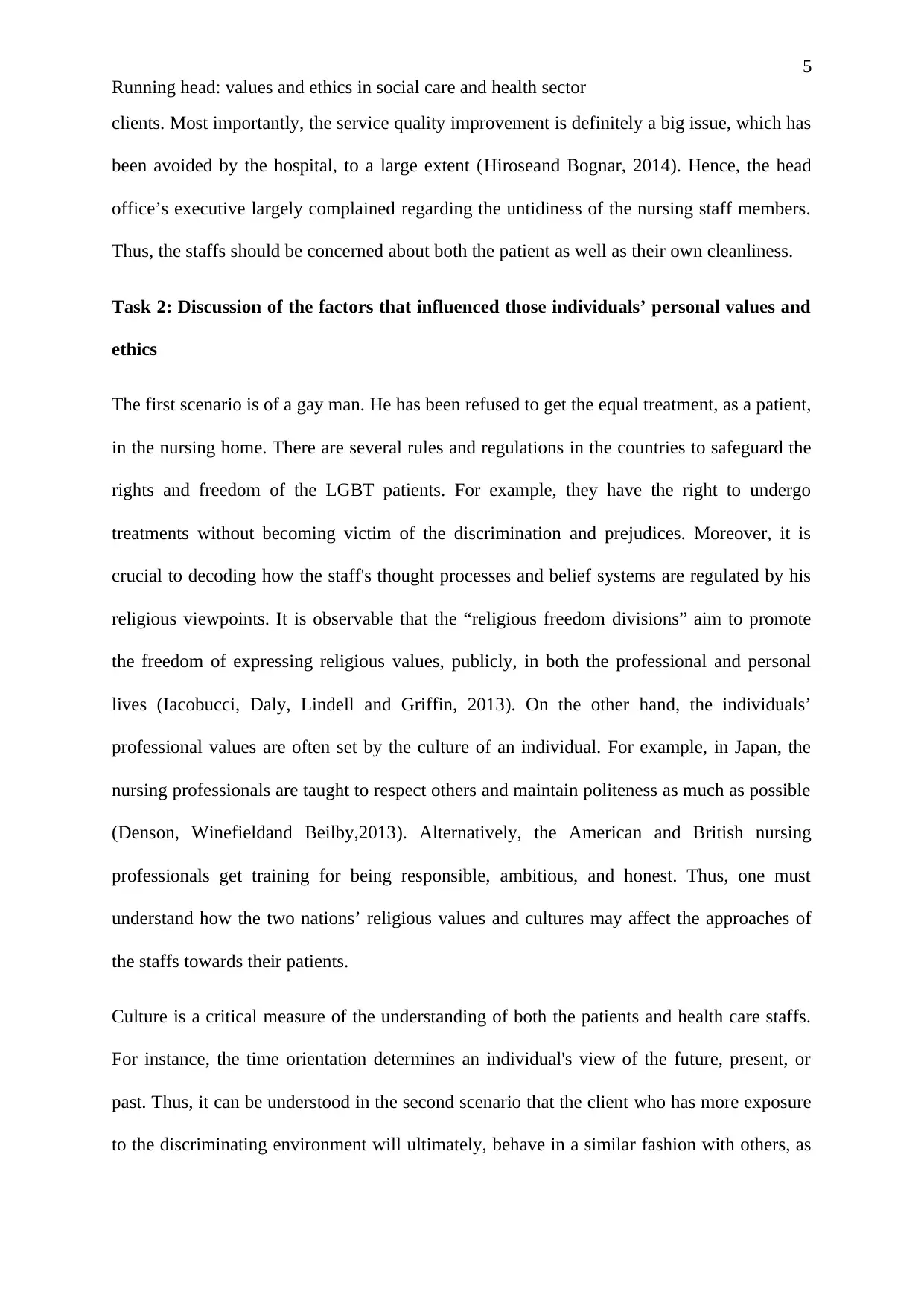
5
Running head: values and ethics in social care and health sector
clients. Most importantly, the service quality improvement is definitely a big issue, which has
been avoided by the hospital, to a large extent (Hiroseand Bognar, 2014). Hence, the head
office’s executive largely complained regarding the untidiness of the nursing staff members.
Thus, the staffs should be concerned about both the patient as well as their own cleanliness.
Task 2: Discussion of the factors that influenced those individuals’ personal values and
ethics
The first scenario is of a gay man. He has been refused to get the equal treatment, as a patient,
in the nursing home. There are several rules and regulations in the countries to safeguard the
rights and freedom of the LGBT patients. For example, they have the right to undergo
treatments without becoming victim of the discrimination and prejudices. Moreover, it is
crucial to decoding how the staff's thought processes and belief systems are regulated by his
religious viewpoints. It is observable that the “religious freedom divisions” aim to promote
the freedom of expressing religious values, publicly, in both the professional and personal
lives (Iacobucci, Daly, Lindell and Griffin, 2013). On the other hand, the individuals’
professional values are often set by the culture of an individual. For example, in Japan, the
nursing professionals are taught to respect others and maintain politeness as much as possible
(Denson, Winefieldand Beilby,2013). Alternatively, the American and British nursing
professionals get training for being responsible, ambitious, and honest. Thus, one must
understand how the two nations’ religious values and cultures may affect the approaches of
the staffs towards their patients.
Culture is a critical measure of the understanding of both the patients and health care staffs.
For instance, the time orientation determines an individual's view of the future, present, or
past. Thus, it can be understood in the second scenario that the client who has more exposure
to the discriminating environment will ultimately, behave in a similar fashion with others, as
Running head: values and ethics in social care and health sector
clients. Most importantly, the service quality improvement is definitely a big issue, which has
been avoided by the hospital, to a large extent (Hiroseand Bognar, 2014). Hence, the head
office’s executive largely complained regarding the untidiness of the nursing staff members.
Thus, the staffs should be concerned about both the patient as well as their own cleanliness.
Task 2: Discussion of the factors that influenced those individuals’ personal values and
ethics
The first scenario is of a gay man. He has been refused to get the equal treatment, as a patient,
in the nursing home. There are several rules and regulations in the countries to safeguard the
rights and freedom of the LGBT patients. For example, they have the right to undergo
treatments without becoming victim of the discrimination and prejudices. Moreover, it is
crucial to decoding how the staff's thought processes and belief systems are regulated by his
religious viewpoints. It is observable that the “religious freedom divisions” aim to promote
the freedom of expressing religious values, publicly, in both the professional and personal
lives (Iacobucci, Daly, Lindell and Griffin, 2013). On the other hand, the individuals’
professional values are often set by the culture of an individual. For example, in Japan, the
nursing professionals are taught to respect others and maintain politeness as much as possible
(Denson, Winefieldand Beilby,2013). Alternatively, the American and British nursing
professionals get training for being responsible, ambitious, and honest. Thus, one must
understand how the two nations’ religious values and cultures may affect the approaches of
the staffs towards their patients.
Culture is a critical measure of the understanding of both the patients and health care staffs.
For instance, the time orientation determines an individual's view of the future, present, or
past. Thus, it can be understood in the second scenario that the client who has more exposure
to the discriminating environment will ultimately, behave in a similar fashion with others, as
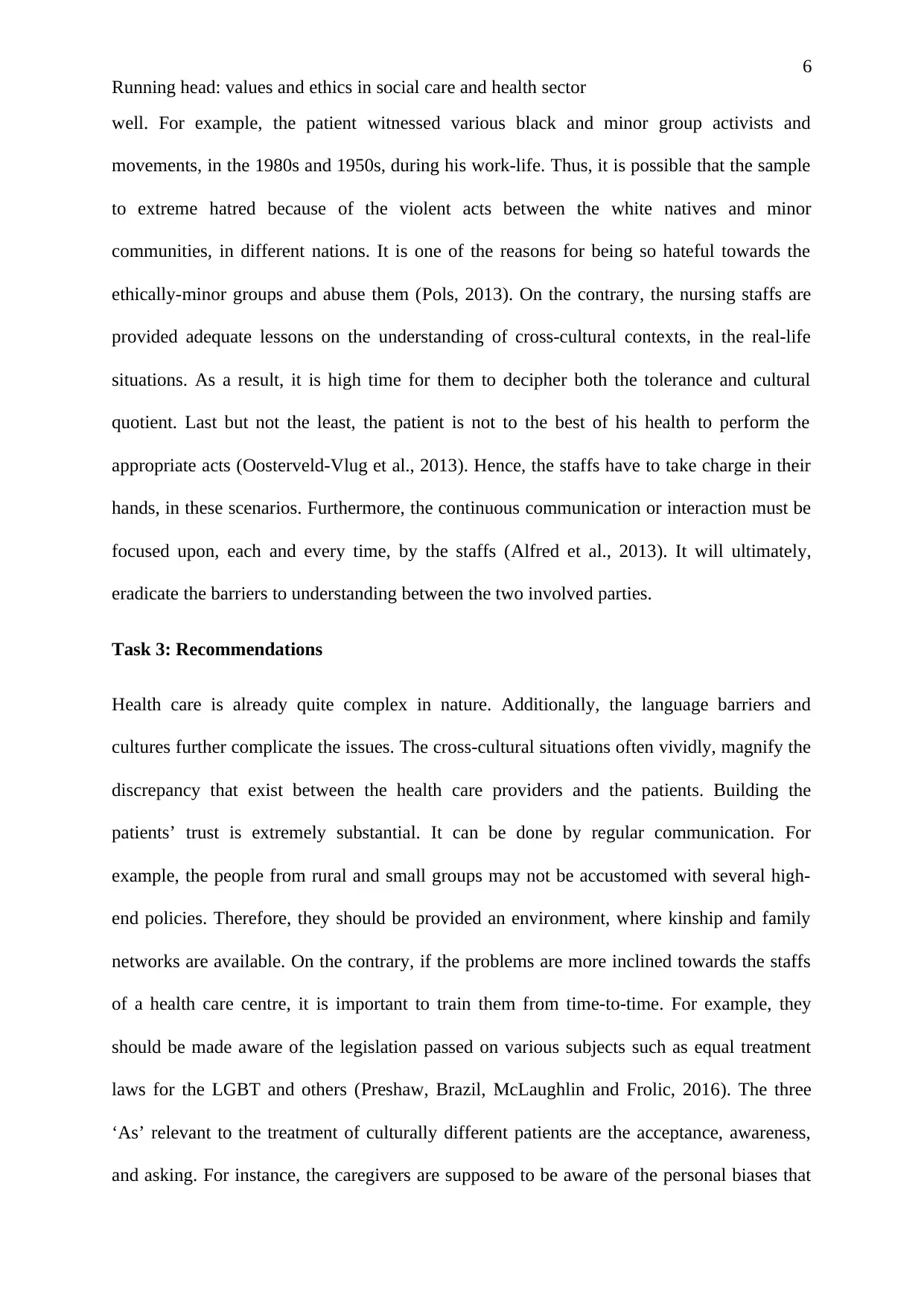
6
Running head: values and ethics in social care and health sector
well. For example, the patient witnessed various black and minor group activists and
movements, in the 1980s and 1950s, during his work-life. Thus, it is possible that the sample
to extreme hatred because of the violent acts between the white natives and minor
communities, in different nations. It is one of the reasons for being so hateful towards the
ethically-minor groups and abuse them (Pols, 2013). On the contrary, the nursing staffs are
provided adequate lessons on the understanding of cross-cultural contexts, in the real-life
situations. As a result, it is high time for them to decipher both the tolerance and cultural
quotient. Last but not the least, the patient is not to the best of his health to perform the
appropriate acts (Oosterveld-Vlug et al., 2013). Hence, the staffs have to take charge in their
hands, in these scenarios. Furthermore, the continuous communication or interaction must be
focused upon, each and every time, by the staffs (Alfred et al., 2013). It will ultimately,
eradicate the barriers to understanding between the two involved parties.
Task 3: Recommendations
Health care is already quite complex in nature. Additionally, the language barriers and
cultures further complicate the issues. The cross-cultural situations often vividly, magnify the
discrepancy that exist between the health care providers and the patients. Building the
patients’ trust is extremely substantial. It can be done by regular communication. For
example, the people from rural and small groups may not be accustomed with several high-
end policies. Therefore, they should be provided an environment, where kinship and family
networks are available. On the contrary, if the problems are more inclined towards the staffs
of a health care centre, it is important to train them from time-to-time. For example, they
should be made aware of the legislation passed on various subjects such as equal treatment
laws for the LGBT and others (Preshaw, Brazil, McLaughlin and Frolic, 2016). The three
‘As’ relevant to the treatment of culturally different patients are the acceptance, awareness,
and asking. For instance, the caregivers are supposed to be aware of the personal biases that
Running head: values and ethics in social care and health sector
well. For example, the patient witnessed various black and minor group activists and
movements, in the 1980s and 1950s, during his work-life. Thus, it is possible that the sample
to extreme hatred because of the violent acts between the white natives and minor
communities, in different nations. It is one of the reasons for being so hateful towards the
ethically-minor groups and abuse them (Pols, 2013). On the contrary, the nursing staffs are
provided adequate lessons on the understanding of cross-cultural contexts, in the real-life
situations. As a result, it is high time for them to decipher both the tolerance and cultural
quotient. Last but not the least, the patient is not to the best of his health to perform the
appropriate acts (Oosterveld-Vlug et al., 2013). Hence, the staffs have to take charge in their
hands, in these scenarios. Furthermore, the continuous communication or interaction must be
focused upon, each and every time, by the staffs (Alfred et al., 2013). It will ultimately,
eradicate the barriers to understanding between the two involved parties.
Task 3: Recommendations
Health care is already quite complex in nature. Additionally, the language barriers and
cultures further complicate the issues. The cross-cultural situations often vividly, magnify the
discrepancy that exist between the health care providers and the patients. Building the
patients’ trust is extremely substantial. It can be done by regular communication. For
example, the people from rural and small groups may not be accustomed with several high-
end policies. Therefore, they should be provided an environment, where kinship and family
networks are available. On the contrary, if the problems are more inclined towards the staffs
of a health care centre, it is important to train them from time-to-time. For example, they
should be made aware of the legislation passed on various subjects such as equal treatment
laws for the LGBT and others (Preshaw, Brazil, McLaughlin and Frolic, 2016). The three
‘As’ relevant to the treatment of culturally different patients are the acceptance, awareness,
and asking. For instance, the caregivers are supposed to be aware of the personal biases that
⊘ This is a preview!⊘
Do you want full access?
Subscribe today to unlock all pages.

Trusted by 1+ million students worldwide
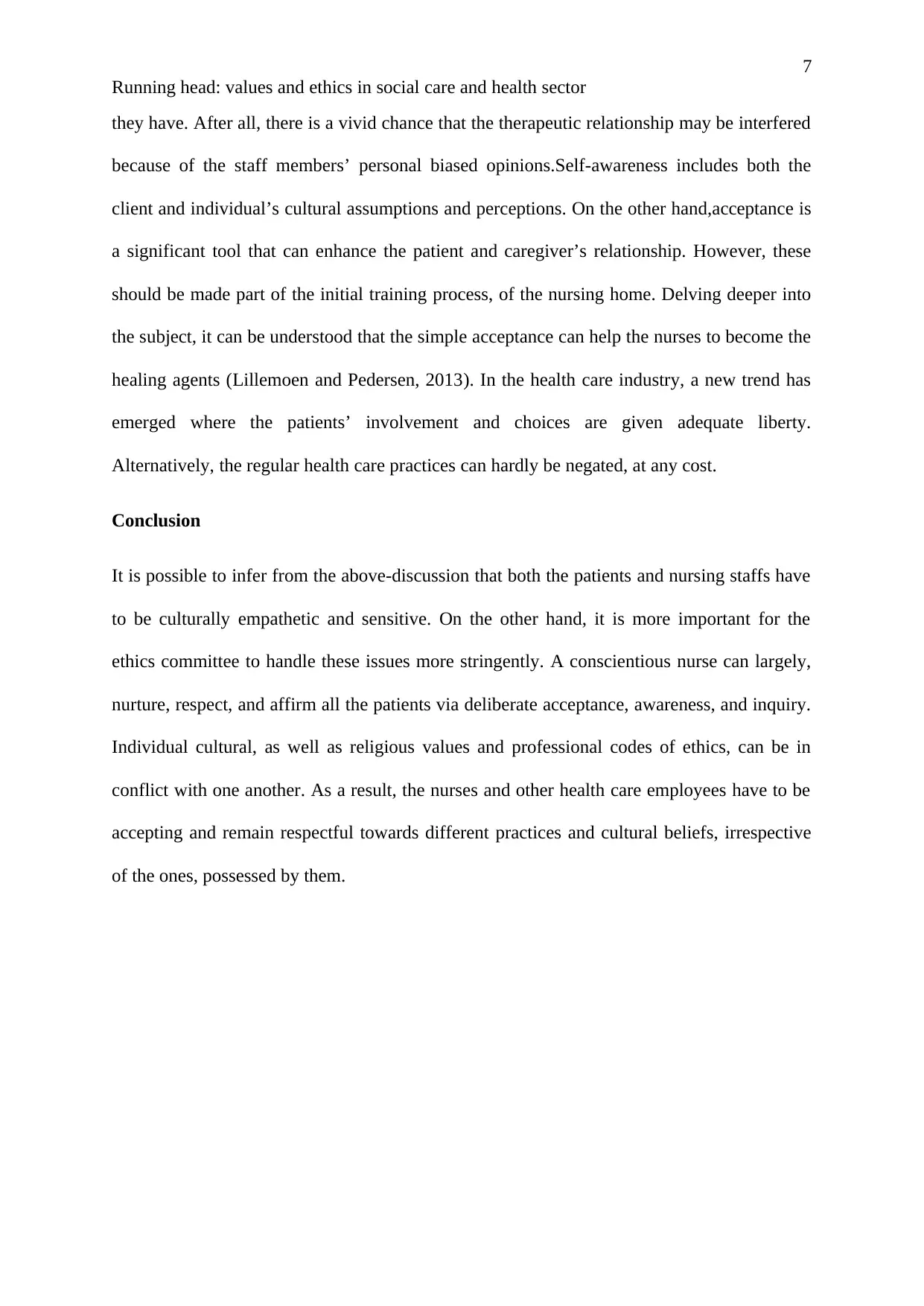
7
Running head: values and ethics in social care and health sector
they have. After all, there is a vivid chance that the therapeutic relationship may be interfered
because of the staff members’ personal biased opinions.Self-awareness includes both the
client and individual’s cultural assumptions and perceptions. On the other hand,acceptance is
a significant tool that can enhance the patient and caregiver’s relationship. However, these
should be made part of the initial training process, of the nursing home. Delving deeper into
the subject, it can be understood that the simple acceptance can help the nurses to become the
healing agents (Lillemoen and Pedersen, 2013). In the health care industry, a new trend has
emerged where the patients’ involvement and choices are given adequate liberty.
Alternatively, the regular health care practices can hardly be negated, at any cost.
Conclusion
It is possible to infer from the above-discussion that both the patients and nursing staffs have
to be culturally empathetic and sensitive. On the other hand, it is more important for the
ethics committee to handle these issues more stringently. A conscientious nurse can largely,
nurture, respect, and affirm all the patients via deliberate acceptance, awareness, and inquiry.
Individual cultural, as well as religious values and professional codes of ethics, can be in
conflict with one another. As a result, the nurses and other health care employees have to be
accepting and remain respectful towards different practices and cultural beliefs, irrespective
of the ones, possessed by them.
Running head: values and ethics in social care and health sector
they have. After all, there is a vivid chance that the therapeutic relationship may be interfered
because of the staff members’ personal biased opinions.Self-awareness includes both the
client and individual’s cultural assumptions and perceptions. On the other hand,acceptance is
a significant tool that can enhance the patient and caregiver’s relationship. However, these
should be made part of the initial training process, of the nursing home. Delving deeper into
the subject, it can be understood that the simple acceptance can help the nurses to become the
healing agents (Lillemoen and Pedersen, 2013). In the health care industry, a new trend has
emerged where the patients’ involvement and choices are given adequate liberty.
Alternatively, the regular health care practices can hardly be negated, at any cost.
Conclusion
It is possible to infer from the above-discussion that both the patients and nursing staffs have
to be culturally empathetic and sensitive. On the other hand, it is more important for the
ethics committee to handle these issues more stringently. A conscientious nurse can largely,
nurture, respect, and affirm all the patients via deliberate acceptance, awareness, and inquiry.
Individual cultural, as well as religious values and professional codes of ethics, can be in
conflict with one another. As a result, the nurses and other health care employees have to be
accepting and remain respectful towards different practices and cultural beliefs, irrespective
of the ones, possessed by them.
Paraphrase This Document
Need a fresh take? Get an instant paraphrase of this document with our AI Paraphraser
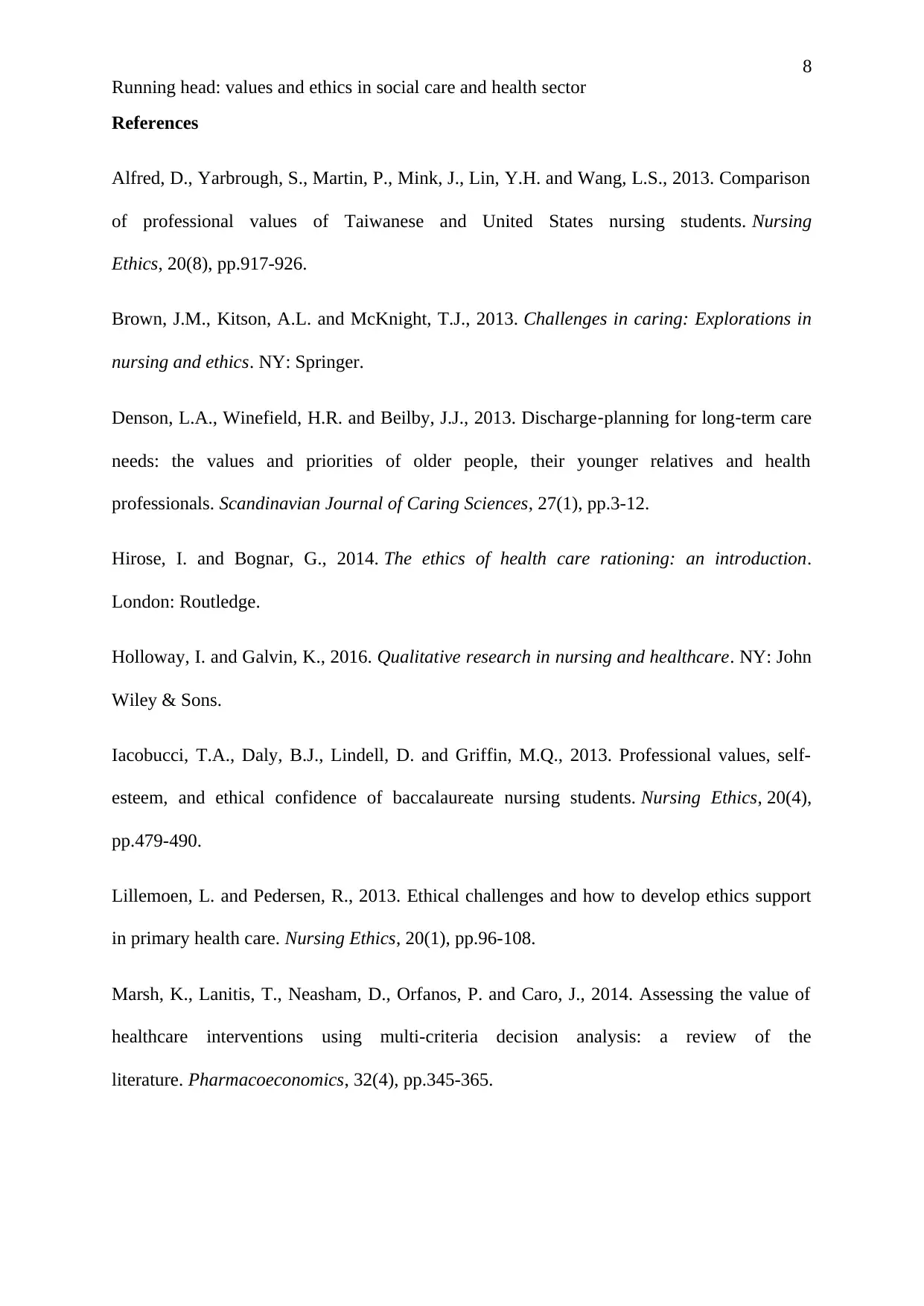
8
Running head: values and ethics in social care and health sector
References
Alfred, D., Yarbrough, S., Martin, P., Mink, J., Lin, Y.H. and Wang, L.S., 2013. Comparison
of professional values of Taiwanese and United States nursing students. Nursing
Ethics, 20(8), pp.917-926.
Brown, J.M., Kitson, A.L. and McKnight, T.J., 2013. Challenges in caring: Explorations in
nursing and ethics. NY: Springer.
Denson, L.A., Winefield, H.R. and Beilby, J.J., 2013. Discharge‐planning for long‐term care
needs: the values and priorities of older people, their younger relatives and health
professionals. Scandinavian Journal of Caring Sciences, 27(1), pp.3-12.
Hirose, I. and Bognar, G., 2014. The ethics of health care rationing: an introduction.
London: Routledge.
Holloway, I. and Galvin, K., 2016. Qualitative research in nursing and healthcare. NY: John
Wiley & Sons.
Iacobucci, T.A., Daly, B.J., Lindell, D. and Griffin, M.Q., 2013. Professional values, self-
esteem, and ethical confidence of baccalaureate nursing students. Nursing Ethics, 20(4),
pp.479-490.
Lillemoen, L. and Pedersen, R., 2013. Ethical challenges and how to develop ethics support
in primary health care. Nursing Ethics, 20(1), pp.96-108.
Marsh, K., Lanitis, T., Neasham, D., Orfanos, P. and Caro, J., 2014. Assessing the value of
healthcare interventions using multi-criteria decision analysis: a review of the
literature. Pharmacoeconomics, 32(4), pp.345-365.
Running head: values and ethics in social care and health sector
References
Alfred, D., Yarbrough, S., Martin, P., Mink, J., Lin, Y.H. and Wang, L.S., 2013. Comparison
of professional values of Taiwanese and United States nursing students. Nursing
Ethics, 20(8), pp.917-926.
Brown, J.M., Kitson, A.L. and McKnight, T.J., 2013. Challenges in caring: Explorations in
nursing and ethics. NY: Springer.
Denson, L.A., Winefield, H.R. and Beilby, J.J., 2013. Discharge‐planning for long‐term care
needs: the values and priorities of older people, their younger relatives and health
professionals. Scandinavian Journal of Caring Sciences, 27(1), pp.3-12.
Hirose, I. and Bognar, G., 2014. The ethics of health care rationing: an introduction.
London: Routledge.
Holloway, I. and Galvin, K., 2016. Qualitative research in nursing and healthcare. NY: John
Wiley & Sons.
Iacobucci, T.A., Daly, B.J., Lindell, D. and Griffin, M.Q., 2013. Professional values, self-
esteem, and ethical confidence of baccalaureate nursing students. Nursing Ethics, 20(4),
pp.479-490.
Lillemoen, L. and Pedersen, R., 2013. Ethical challenges and how to develop ethics support
in primary health care. Nursing Ethics, 20(1), pp.96-108.
Marsh, K., Lanitis, T., Neasham, D., Orfanos, P. and Caro, J., 2014. Assessing the value of
healthcare interventions using multi-criteria decision analysis: a review of the
literature. Pharmacoeconomics, 32(4), pp.345-365.
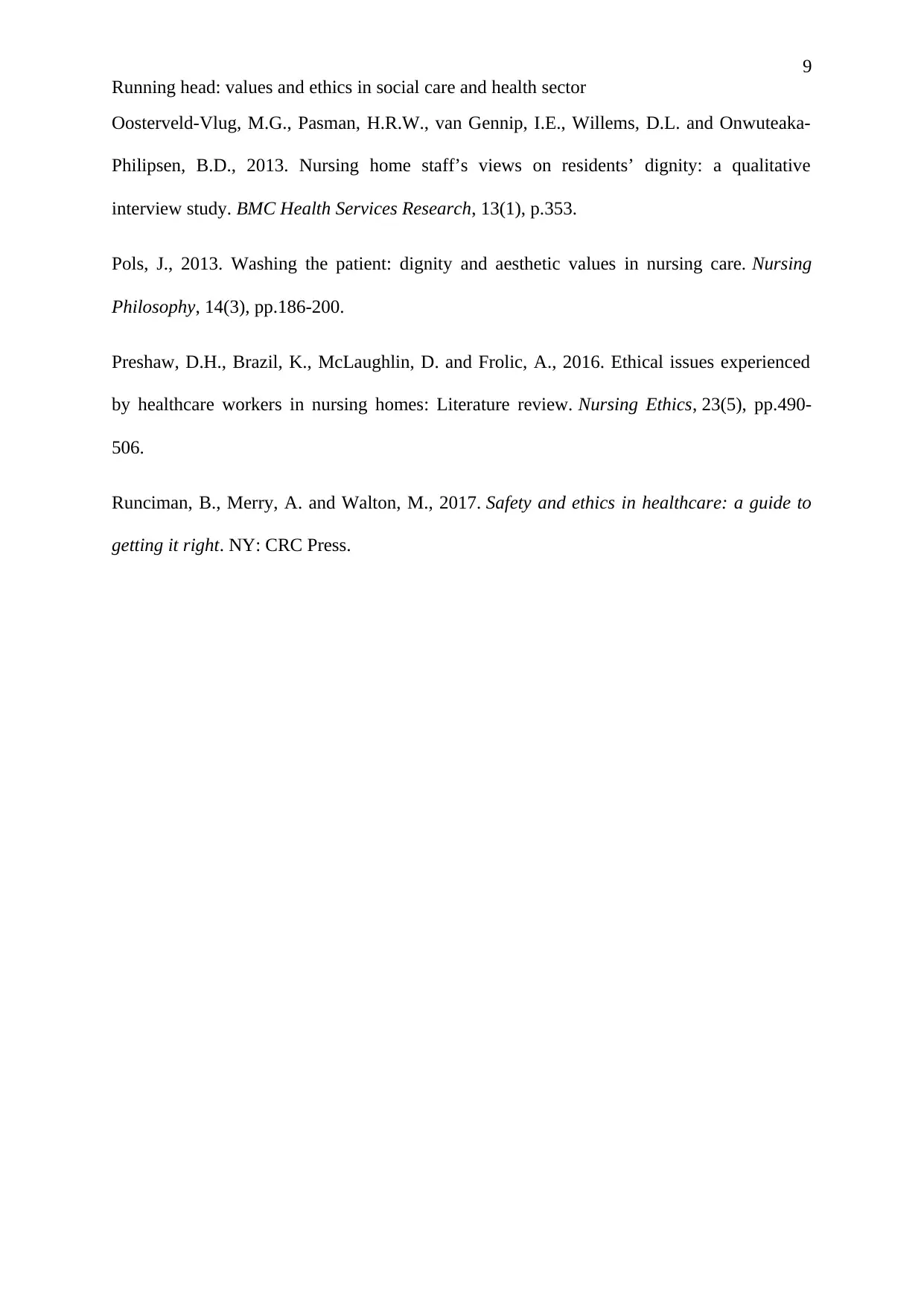
9
Running head: values and ethics in social care and health sector
Oosterveld-Vlug, M.G., Pasman, H.R.W., van Gennip, I.E., Willems, D.L. and Onwuteaka-
Philipsen, B.D., 2013. Nursing home staff’s views on residents’ dignity: a qualitative
interview study. BMC Health Services Research, 13(1), p.353.
Pols, J., 2013. Washing the patient: dignity and aesthetic values in nursing care. Nursing
Philosophy, 14(3), pp.186-200.
Preshaw, D.H., Brazil, K., McLaughlin, D. and Frolic, A., 2016. Ethical issues experienced
by healthcare workers in nursing homes: Literature review. Nursing Ethics, 23(5), pp.490-
506.
Runciman, B., Merry, A. and Walton, M., 2017. Safety and ethics in healthcare: a guide to
getting it right. NY: CRC Press.
Running head: values and ethics in social care and health sector
Oosterveld-Vlug, M.G., Pasman, H.R.W., van Gennip, I.E., Willems, D.L. and Onwuteaka-
Philipsen, B.D., 2013. Nursing home staff’s views on residents’ dignity: a qualitative
interview study. BMC Health Services Research, 13(1), p.353.
Pols, J., 2013. Washing the patient: dignity and aesthetic values in nursing care. Nursing
Philosophy, 14(3), pp.186-200.
Preshaw, D.H., Brazil, K., McLaughlin, D. and Frolic, A., 2016. Ethical issues experienced
by healthcare workers in nursing homes: Literature review. Nursing Ethics, 23(5), pp.490-
506.
Runciman, B., Merry, A. and Walton, M., 2017. Safety and ethics in healthcare: a guide to
getting it right. NY: CRC Press.
⊘ This is a preview!⊘
Do you want full access?
Subscribe today to unlock all pages.

Trusted by 1+ million students worldwide
1 out of 9
Related Documents
Your All-in-One AI-Powered Toolkit for Academic Success.
+13062052269
info@desklib.com
Available 24*7 on WhatsApp / Email
![[object Object]](/_next/static/media/star-bottom.7253800d.svg)
Unlock your academic potential
Copyright © 2020–2026 A2Z Services. All Rights Reserved. Developed and managed by ZUCOL.





